Examining the Value of Information Through RBV and IT Portfolio Theory
VerifiedAdded on 2023/01/17
|5
|1322
|69
Report
AI Summary
This report delves into the value of information within a business context, employing the Resource-Based View (RBV) of the firm and IT portfolio theory to analyze competitive advantages in a disruptive market. The report uses Nettavisen as a case study. It examines how resources, particularly those with VRIO characteristics, contribute to sustainable competitive advantages. The study combines the principles of RBV and IT portfolio theory, evaluating resource diversity and immobility. The report highlights the importance of human capital management, technology adoption, and the strategic use of social media (Facebook and Google) for organizational marketing. Furthermore, it explores Google's competitive advantages, including its infrastructure, new services, and market share. The analysis concludes that the combination of IT portfolio theory and RBV can be a source of competitive advantages.
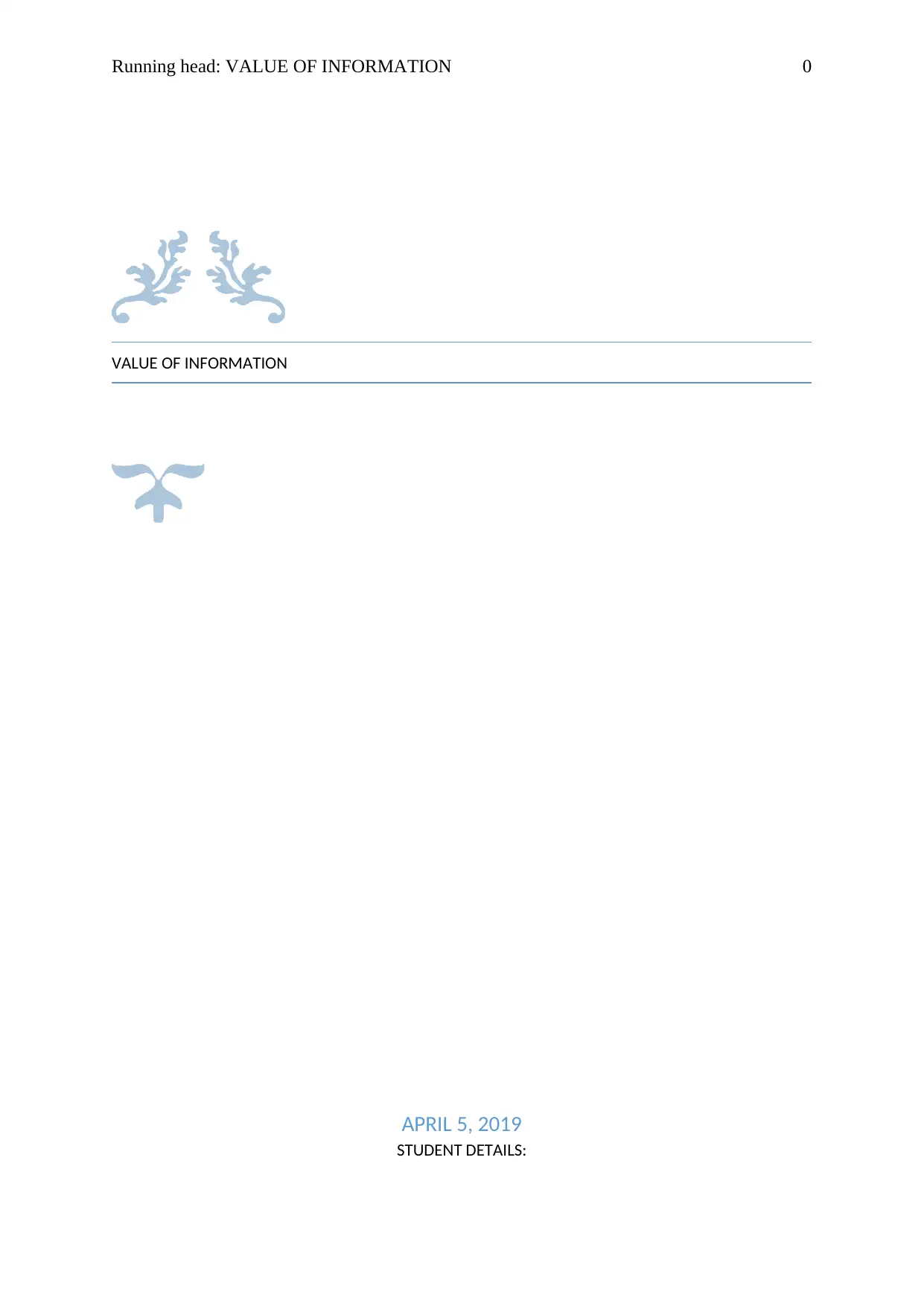
Running head: VALUE OF INFORMATION 0
VALUE OF INFORMATION
APRIL 5, 2019
STUDENT DETAILS:
VALUE OF INFORMATION
APRIL 5, 2019
STUDENT DETAILS:
Paraphrase This Document
Need a fresh take? Get an instant paraphrase of this document with our AI Paraphraser
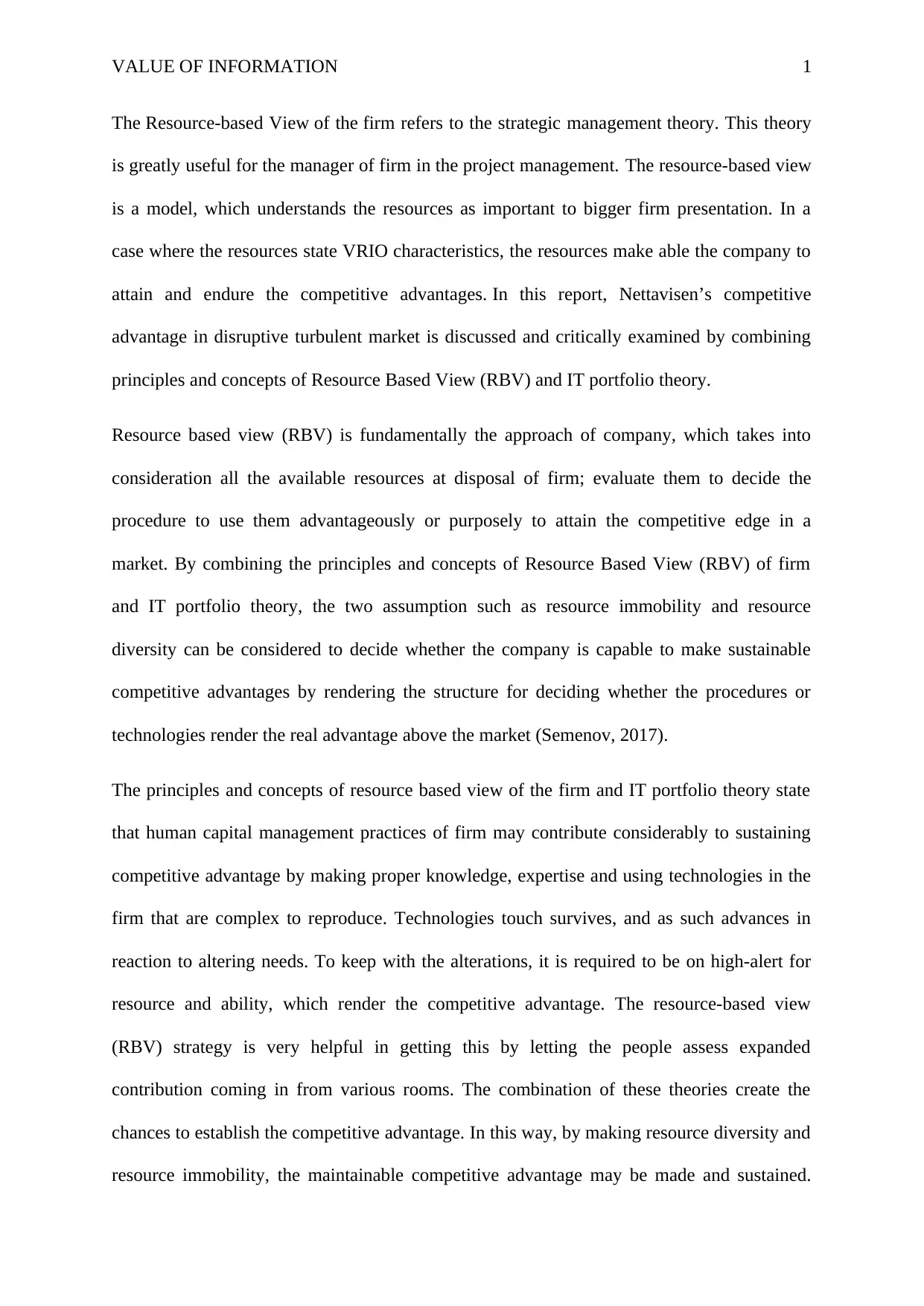
VALUE OF INFORMATION 1
The Resource-based View of the firm refers to the strategic management theory. This theory
is greatly useful for the manager of firm in the project management. The resource-based view
is a model, which understands the resources as important to bigger firm presentation. In a
case where the resources state VRIO characteristics, the resources make able the company to
attain and endure the competitive advantages. In this report, Nettavisen’s competitive
advantage in disruptive turbulent market is discussed and critically examined by combining
principles and concepts of Resource Based View (RBV) and IT portfolio theory.
Resource based view (RBV) is fundamentally the approach of company, which takes into
consideration all the available resources at disposal of firm; evaluate them to decide the
procedure to use them advantageously or purposely to attain the competitive edge in a
market. By combining the principles and concepts of Resource Based View (RBV) of firm
and IT portfolio theory, the two assumption such as resource immobility and resource
diversity can be considered to decide whether the company is capable to make sustainable
competitive advantages by rendering the structure for deciding whether the procedures or
technologies render the real advantage above the market (Semenov, 2017).
The principles and concepts of resource based view of the firm and IT portfolio theory state
that human capital management practices of firm may contribute considerably to sustaining
competitive advantage by making proper knowledge, expertise and using technologies in the
firm that are complex to reproduce. Technologies touch survives, and as such advances in
reaction to altering needs. To keep with the alterations, it is required to be on high-alert for
resource and ability, which render the competitive advantage. The resource-based view
(RBV) strategy is very helpful in getting this by letting the people assess expanded
contribution coming in from various rooms. The combination of these theories create the
chances to establish the competitive advantage. In this way, by making resource diversity and
resource immobility, the maintainable competitive advantage may be made and sustained.
The Resource-based View of the firm refers to the strategic management theory. This theory
is greatly useful for the manager of firm in the project management. The resource-based view
is a model, which understands the resources as important to bigger firm presentation. In a
case where the resources state VRIO characteristics, the resources make able the company to
attain and endure the competitive advantages. In this report, Nettavisen’s competitive
advantage in disruptive turbulent market is discussed and critically examined by combining
principles and concepts of Resource Based View (RBV) and IT portfolio theory.
Resource based view (RBV) is fundamentally the approach of company, which takes into
consideration all the available resources at disposal of firm; evaluate them to decide the
procedure to use them advantageously or purposely to attain the competitive edge in a
market. By combining the principles and concepts of Resource Based View (RBV) of firm
and IT portfolio theory, the two assumption such as resource immobility and resource
diversity can be considered to decide whether the company is capable to make sustainable
competitive advantages by rendering the structure for deciding whether the procedures or
technologies render the real advantage above the market (Semenov, 2017).
The principles and concepts of resource based view of the firm and IT portfolio theory state
that human capital management practices of firm may contribute considerably to sustaining
competitive advantage by making proper knowledge, expertise and using technologies in the
firm that are complex to reproduce. Technologies touch survives, and as such advances in
reaction to altering needs. To keep with the alterations, it is required to be on high-alert for
resource and ability, which render the competitive advantage. The resource-based view
(RBV) strategy is very helpful in getting this by letting the people assess expanded
contribution coming in from various rooms. The combination of these theories create the
chances to establish the competitive advantage. In this way, by making resource diversity and
resource immobility, the maintainable competitive advantage may be made and sustained.
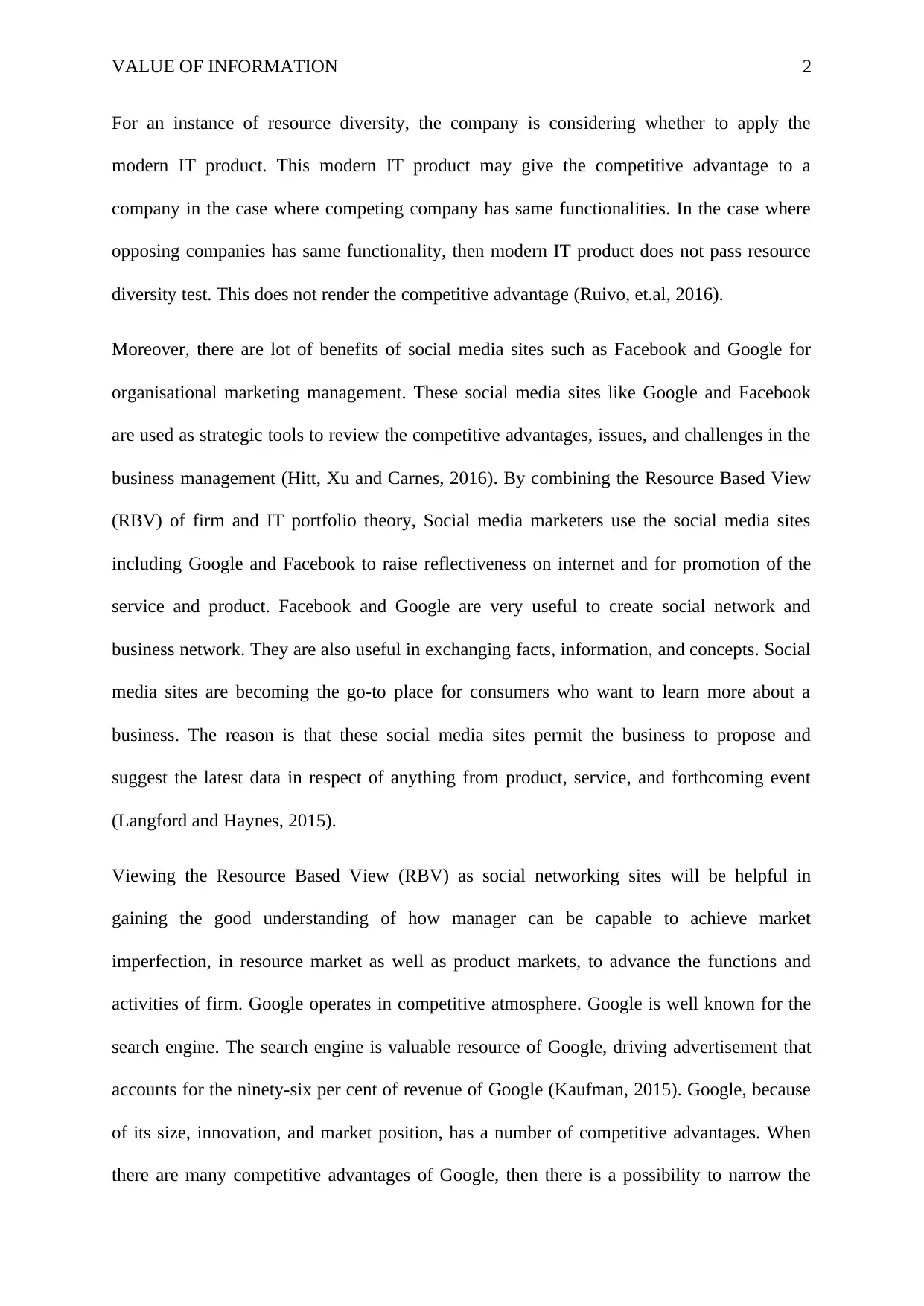
VALUE OF INFORMATION 2
For an instance of resource diversity, the company is considering whether to apply the
modern IT product. This modern IT product may give the competitive advantage to a
company in the case where competing company has same functionalities. In the case where
opposing companies has same functionality, then modern IT product does not pass resource
diversity test. This does not render the competitive advantage (Ruivo, et.al, 2016).
Moreover, there are lot of benefits of social media sites such as Facebook and Google for
organisational marketing management. These social media sites like Google and Facebook
are used as strategic tools to review the competitive advantages, issues, and challenges in the
business management (Hitt, Xu and Carnes, 2016). By combining the Resource Based View
(RBV) of firm and IT portfolio theory, Social media marketers use the social media sites
including Google and Facebook to raise reflectiveness on internet and for promotion of the
service and product. Facebook and Google are very useful to create social network and
business network. They are also useful in exchanging facts, information, and concepts. Social
media sites are becoming the go-to place for consumers who want to learn more about a
business. The reason is that these social media sites permit the business to propose and
suggest the latest data in respect of anything from product, service, and forthcoming event
(Langford and Haynes, 2015).
Viewing the Resource Based View (RBV) as social networking sites will be helpful in
gaining the good understanding of how manager can be capable to achieve market
imperfection, in resource market as well as product markets, to advance the functions and
activities of firm. Google operates in competitive atmosphere. Google is well known for the
search engine. The search engine is valuable resource of Google, driving advertisement that
accounts for the ninety-six per cent of revenue of Google (Kaufman, 2015). Google, because
of its size, innovation, and market position, has a number of competitive advantages. When
there are many competitive advantages of Google, then there is a possibility to narrow the
For an instance of resource diversity, the company is considering whether to apply the
modern IT product. This modern IT product may give the competitive advantage to a
company in the case where competing company has same functionalities. In the case where
opposing companies has same functionality, then modern IT product does not pass resource
diversity test. This does not render the competitive advantage (Ruivo, et.al, 2016).
Moreover, there are lot of benefits of social media sites such as Facebook and Google for
organisational marketing management. These social media sites like Google and Facebook
are used as strategic tools to review the competitive advantages, issues, and challenges in the
business management (Hitt, Xu and Carnes, 2016). By combining the Resource Based View
(RBV) of firm and IT portfolio theory, Social media marketers use the social media sites
including Google and Facebook to raise reflectiveness on internet and for promotion of the
service and product. Facebook and Google are very useful to create social network and
business network. They are also useful in exchanging facts, information, and concepts. Social
media sites are becoming the go-to place for consumers who want to learn more about a
business. The reason is that these social media sites permit the business to propose and
suggest the latest data in respect of anything from product, service, and forthcoming event
(Langford and Haynes, 2015).
Viewing the Resource Based View (RBV) as social networking sites will be helpful in
gaining the good understanding of how manager can be capable to achieve market
imperfection, in resource market as well as product markets, to advance the functions and
activities of firm. Google operates in competitive atmosphere. Google is well known for the
search engine. The search engine is valuable resource of Google, driving advertisement that
accounts for the ninety-six per cent of revenue of Google (Kaufman, 2015). Google, because
of its size, innovation, and market position, has a number of competitive advantages. When
there are many competitive advantages of Google, then there is a possibility to narrow the
⊘ This is a preview!⊘
Do you want full access?
Subscribe today to unlock all pages.

Trusted by 1+ million students worldwide
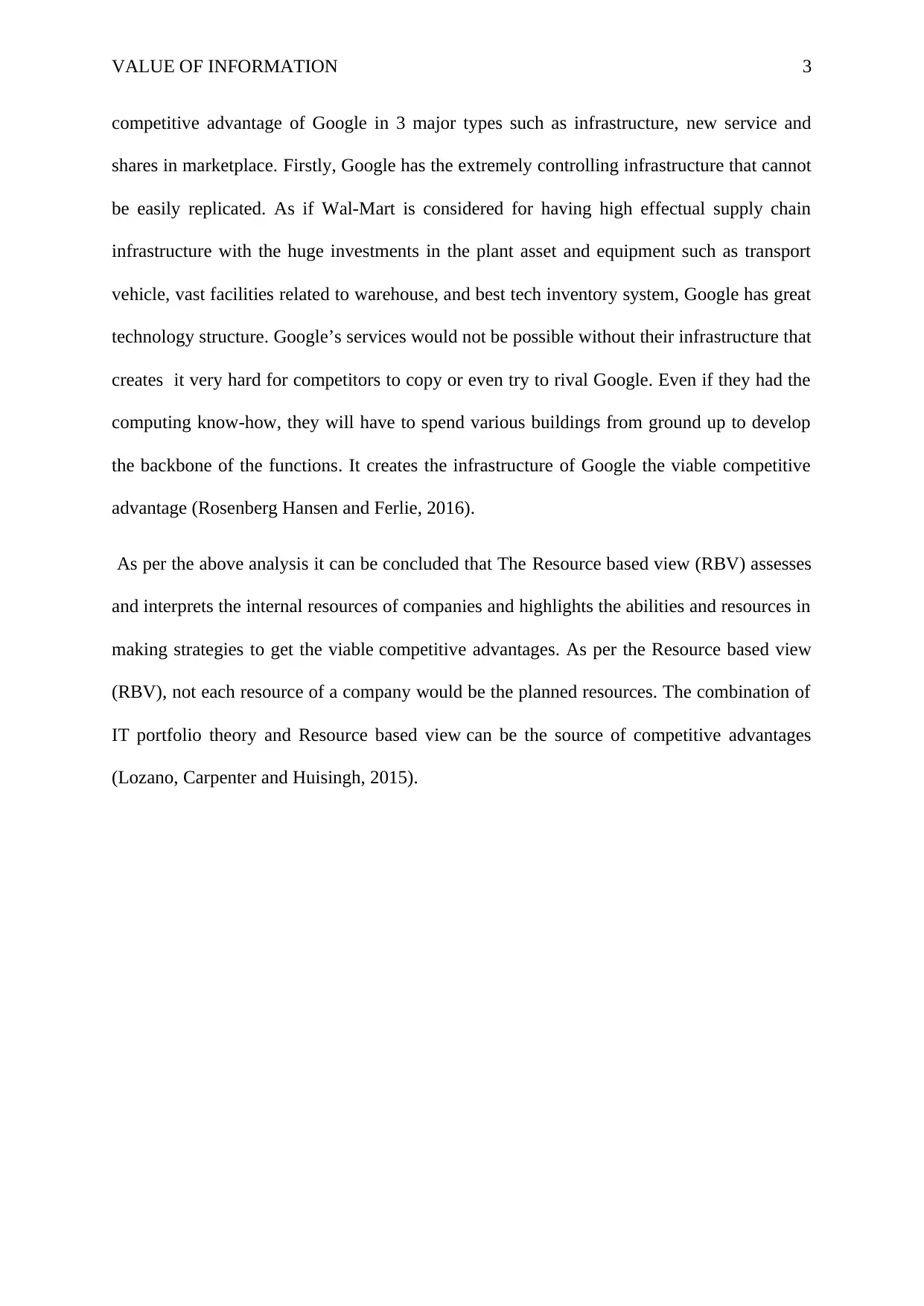
VALUE OF INFORMATION 3
competitive advantage of Google in 3 major types such as infrastructure, new service and
shares in marketplace. Firstly, Google has the extremely controlling infrastructure that cannot
be easily replicated. As if Wal-Mart is considered for having high effectual supply chain
infrastructure with the huge investments in the plant asset and equipment such as transport
vehicle, vast facilities related to warehouse, and best tech inventory system, Google has great
technology structure. Google’s services would not be possible without their infrastructure that
creates it very hard for competitors to copy or even try to rival Google. Even if they had the
computing know-how, they will have to spend various buildings from ground up to develop
the backbone of the functions. It creates the infrastructure of Google the viable competitive
advantage (Rosenberg Hansen and Ferlie, 2016).
As per the above analysis it can be concluded that The Resource based view (RBV) assesses
and interprets the internal resources of companies and highlights the abilities and resources in
making strategies to get the viable competitive advantages. As per the Resource based view
(RBV), not each resource of a company would be the planned resources. The combination of
IT portfolio theory and Resource based view can be the source of competitive advantages
(Lozano, Carpenter and Huisingh, 2015).
competitive advantage of Google in 3 major types such as infrastructure, new service and
shares in marketplace. Firstly, Google has the extremely controlling infrastructure that cannot
be easily replicated. As if Wal-Mart is considered for having high effectual supply chain
infrastructure with the huge investments in the plant asset and equipment such as transport
vehicle, vast facilities related to warehouse, and best tech inventory system, Google has great
technology structure. Google’s services would not be possible without their infrastructure that
creates it very hard for competitors to copy or even try to rival Google. Even if they had the
computing know-how, they will have to spend various buildings from ground up to develop
the backbone of the functions. It creates the infrastructure of Google the viable competitive
advantage (Rosenberg Hansen and Ferlie, 2016).
As per the above analysis it can be concluded that The Resource based view (RBV) assesses
and interprets the internal resources of companies and highlights the abilities and resources in
making strategies to get the viable competitive advantages. As per the Resource based view
(RBV), not each resource of a company would be the planned resources. The combination of
IT portfolio theory and Resource based view can be the source of competitive advantages
(Lozano, Carpenter and Huisingh, 2015).
Paraphrase This Document
Need a fresh take? Get an instant paraphrase of this document with our AI Paraphraser
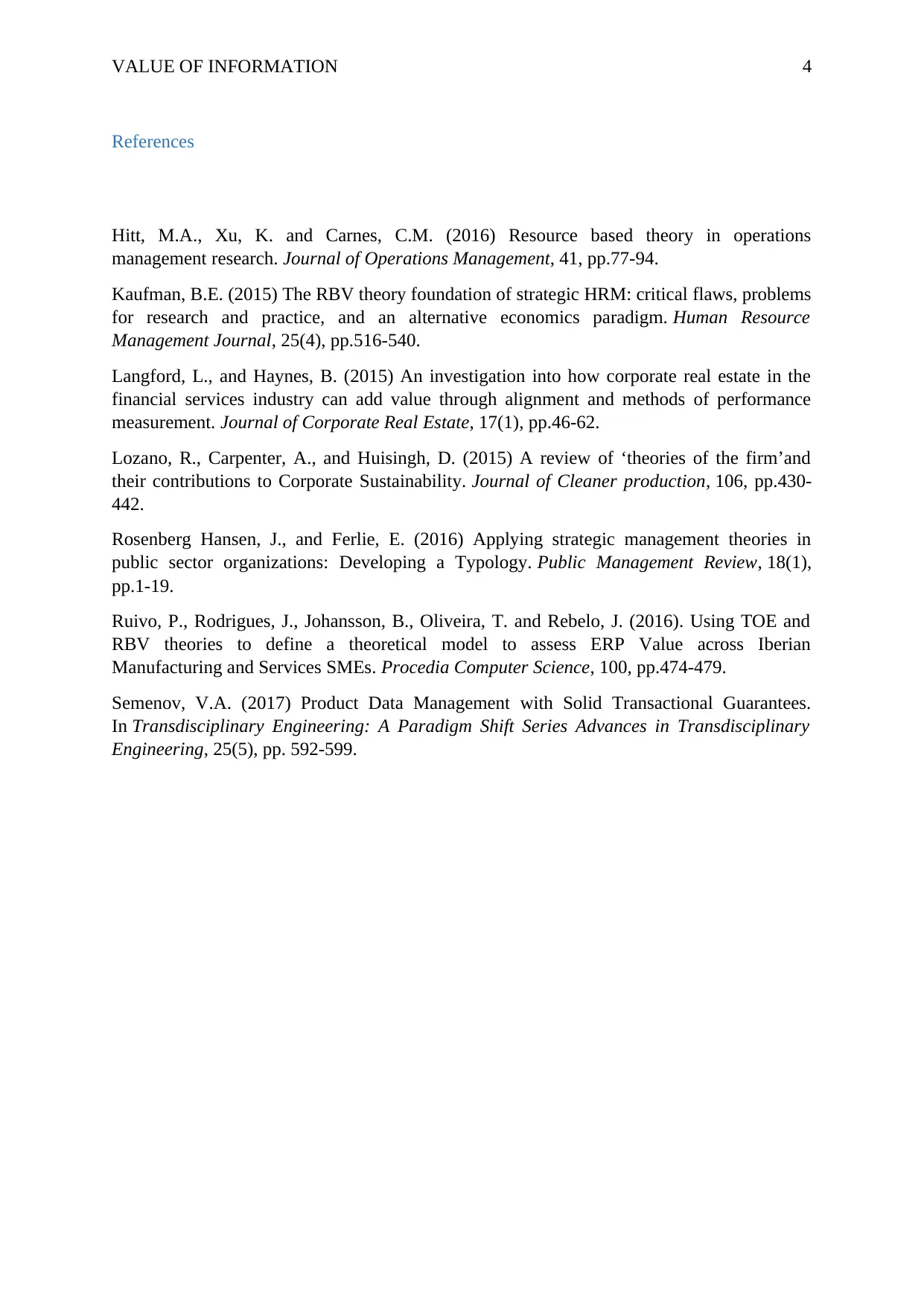
VALUE OF INFORMATION 4
References
Hitt, M.A., Xu, K. and Carnes, C.M. (2016) Resource based theory in operations
management research. Journal of Operations Management, 41, pp.77-94.
Kaufman, B.E. (2015) The RBV theory foundation of strategic HRM: critical flaws, problems
for research and practice, and an alternative economics paradigm. Human Resource
Management Journal, 25(4), pp.516-540.
Langford, L., and Haynes, B. (2015) An investigation into how corporate real estate in the
financial services industry can add value through alignment and methods of performance
measurement. Journal of Corporate Real Estate, 17(1), pp.46-62.
Lozano, R., Carpenter, A., and Huisingh, D. (2015) A review of ‘theories of the firm’and
their contributions to Corporate Sustainability. Journal of Cleaner production, 106, pp.430-
442.
Rosenberg Hansen, J., and Ferlie, E. (2016) Applying strategic management theories in
public sector organizations: Developing a Typology. Public Management Review, 18(1),
pp.1-19.
Ruivo, P., Rodrigues, J., Johansson, B., Oliveira, T. and Rebelo, J. (2016). Using TOE and
RBV theories to define a theoretical model to assess ERP Value across Iberian
Manufacturing and Services SMEs. Procedia Computer Science, 100, pp.474-479.
Semenov, V.A. (2017) Product Data Management with Solid Transactional Guarantees.
In Transdisciplinary Engineering: A Paradigm Shift Series Advances in Transdisciplinary
Engineering, 25(5), pp. 592-599.
References
Hitt, M.A., Xu, K. and Carnes, C.M. (2016) Resource based theory in operations
management research. Journal of Operations Management, 41, pp.77-94.
Kaufman, B.E. (2015) The RBV theory foundation of strategic HRM: critical flaws, problems
for research and practice, and an alternative economics paradigm. Human Resource
Management Journal, 25(4), pp.516-540.
Langford, L., and Haynes, B. (2015) An investigation into how corporate real estate in the
financial services industry can add value through alignment and methods of performance
measurement. Journal of Corporate Real Estate, 17(1), pp.46-62.
Lozano, R., Carpenter, A., and Huisingh, D. (2015) A review of ‘theories of the firm’and
their contributions to Corporate Sustainability. Journal of Cleaner production, 106, pp.430-
442.
Rosenberg Hansen, J., and Ferlie, E. (2016) Applying strategic management theories in
public sector organizations: Developing a Typology. Public Management Review, 18(1),
pp.1-19.
Ruivo, P., Rodrigues, J., Johansson, B., Oliveira, T. and Rebelo, J. (2016). Using TOE and
RBV theories to define a theoretical model to assess ERP Value across Iberian
Manufacturing and Services SMEs. Procedia Computer Science, 100, pp.474-479.
Semenov, V.A. (2017) Product Data Management with Solid Transactional Guarantees.
In Transdisciplinary Engineering: A Paradigm Shift Series Advances in Transdisciplinary
Engineering, 25(5), pp. 592-599.
1 out of 5
Related Documents
Your All-in-One AI-Powered Toolkit for Academic Success.
+13062052269
info@desklib.com
Available 24*7 on WhatsApp / Email
![[object Object]](/_next/static/media/star-bottom.7253800d.svg)
Unlock your academic potential
Copyright © 2020–2025 A2Z Services. All Rights Reserved. Developed and managed by ZUCOL.




